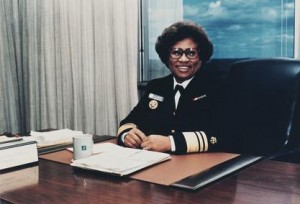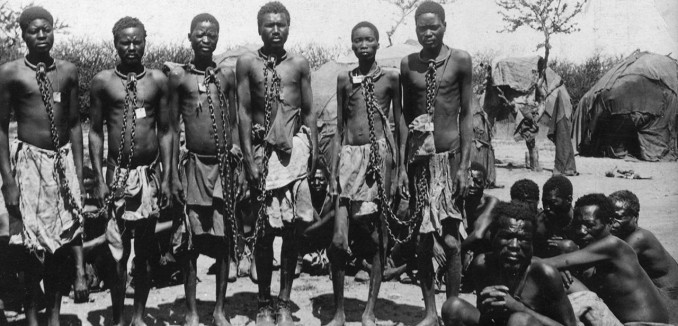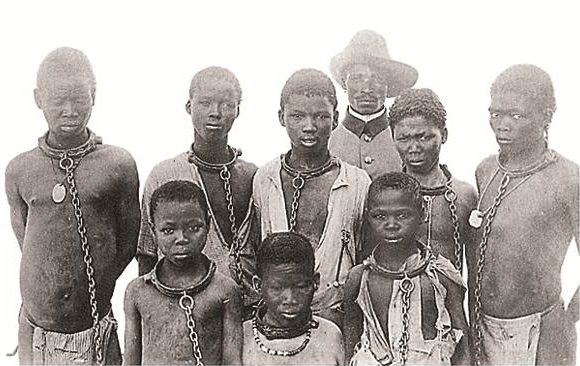In recent years, too many in the African American community have expressed a disconnect to Holocaust topics, seeing the genocide of Jews as someone else’s nightmare. After all, African Americans are still struggling to achieve general recognition of the barbarity of the Middle Passage, the inhumanity of slavery, the oppression of Jim Crow, and the battle for modern civil rights. For many in that community, the murder of six million Jews, and millions of other Europeans, occurred in a faraway place where they had no involvement.
However, a deeper look shows that proto-Nazi ideology before the Third Reich, as well as Nazi-era policy and Hitler’s post-war legacy, deeply impacted Africans, Afro-Germans, and African Americans throughout the twentieth century. America’s black community has, in fact, a mighty stake in this topic.
Understanding the Nazi Reich and the Holocaust is important for blacks just as it is for other communities, including Roma people, people with disabilities, the LGBT community, Jehovah’s Witnesses, and many other groups in addition to Jews. The dots are well known to many scholars, but rarely connected to form a distinct historical nexus for either the Holocaust or the African American communities.
This is understandable. The saga behind these connections started decades before the Third Reich came into existence, in a savage episode on another continent that targeted a completely different racial and ethnic group for death and destruction.
But the horrors visited on another defenseless group endured and became a template for the Final Solution. Students of the Holocaust are accustomed to looking backward long before the Third Reich and long after the demise of the Nazi war machine. African Americans should do the same.
It all begins with the oft-overlooked first genocide of the twentieth century: Germany’s deliberate extermination in 1904 of the Herero and Nama tribespeople in colonial Southwest Africa, now known as Namibia. The atrocities included explicit extermination orders, mass shootings, bonfires immolating wounded or starving Africans, the wearing of identification numbers, and organized transport in cattle cars to concentration camps. One of these camps, Shark Island, was considered a “death by labor” camp. In its campaign against the Africans, the German authorities introduced several terms like Konzentrationslager or concentration camp, untermenschen or subhumans, Mischlinge or mixed race, which all contributed to anti-race mixing laws.
Many of the veterans of Germany’s Southwest Africa extermination campaign went on to become key Nazi activists or otherwise inspired major figures in the Third Reich. For example, Hermann Goering idolized his father, Heinrich, for his role as governor of Southwest Africa. Goering’s 1939 official Nazi biography records reveal that the young Goering “was even more thrilled by his [father’s] accounts of his pioneer work as Reichskommissar for South-West Africa … and his fights with the Herero.” Years later, Goering swore under oath that of the leading “points which are significant with relation to my later development,” he counted among the top four as “the position of my father as first Governor of Southwest Africa.”
In the 1920s, former colonial Trooper Franz Ritter von Epp went on to hire Adolf Hitler and fund the purchase of the Nazi newspaper Völkische Beobachter. With Ernst Röhm, von Epp helped found the Stormtroopers, the Nazi Party’s first paramilitary group. The Stormtroopers, or SA, even adopted the desert sand-colored brown shirt uniforms worn by the troops deployed in Africa.
After the Treaty of Versailles stripped Germany of its African colonies, German citizens were shocked to see African soldiers patrolling their streets. It is not widely known that when France occupied post-World War 1 Germany, it deployed 20,000 to 40,000 colonial African troops. The Germans reacted with a bitter national protest movement, imbued with sexual imagery, called “Black Shame on the Rhine.” When a generation of Afro-Germans arose, denigrated by Hitler and the Nazis as “Rhineland Bastards,” they were among the first to be forcibly sterilized.
When the Nazis came to power, like throngs of other loyal Germans, some Afro-Germans tried to join the Nazi Party. Hans Massaquoi, son of a Liberian diplomat and a German woman, was among those who wanted to sign up with his local branch of the Hitler Youth, just like the rest of his schoolmates. Young Hans was astonished to discover that the 1935 Nuremburg Laws, defining German blood and racial status, applied to him—denying him admittance. His teacher reluctantly told him that joining the Hitler Youth was now impossible. “But I am German,” implored Hans, “my Mother says I’m German just like anybody else.” Nearly hysterical, he pressured his incredulous mother to take him to the nearest Hitler Youth recruitment home, where he was roundly told to leave.
From that moment on, Massaquoi learned to live with the twin fears that the Gestapo would knock on his door or that Allied bombs would rain down on the roof. After the war, Massaquoi was able to emigrate to the United States, where he became a paratrooper with the 82nd Airborne Division. Later, Hans became a marcher alongside Martin Luther King in Chicago. In Chicago, he took a job with Jet Magazine and then Ebony, where he rose to become the managing editor.
Ironically, African Americans were impacted beneficially by Nazi policy again in the thirties, when refugee Jewish professors, ousted from their posts in Germany, immigrated to the United States. Some 50 such refugees accepted teaching positions in historically black colleges and universities, helping to mentor the generation that fought the civil rights struggle.
Among the students who credit the inspiration of German-Jewish professors is Joyce Ladner, who went on to organize civil rights protests with Medgar Evers and who would later rise to the leadership of the Student Nonviolent Coordinating Committee [SNCC] and the Congress on Racial Equality [CORE]. Ladner’s mentor was Ernst Borinski, a Jewish sociologist who arrived from Germany in 1938 and eventually taught at Tougaloo College in Mississippi. Others include Dr. Joycelyn Elders, who went from being mentored by a German-Jewish professor to a distinguished career in medicine. In 1993, she became Surgeon General of the United States. “The German-Jewish professors had a tremendous impact on young blacks in the South,” summed up African-American attorney Jim McWilliams, who attended Talladega College.
 In the forties, when African American soldiers were deployed to Europe, Nazi soldiers who encountered them treated them mercilessly, often committing massacres and war crimes against POWs.
In the forties, when African American soldiers were deployed to Europe, Nazi soldiers who encountered them treated them mercilessly, often committing massacres and war crimes against POWs.
After the fall of Berlin, returning African American soldiers discovered Nazi racial policy was in force in some 27 U.S. states that had adopted forced sterilization laws based on corrupt German eugenic pseudoscience. Ironically, this race science had been nurtured in America first and then transplanted to Germany. In state after state, eugenic boards quoted Nazi race theory and statutes as justification to sterilize blacks, and even confine them in camps as a social protective measure. In Connecticut, one state program even sought to implement Nazi-style race-based expulsions and organized euthanasia of those deemed unworthy of life.
We have only begun to chart the impact of German policy on those of African descent. Such research remains almost completely unfunded and indeed unsupported. However, this much is certain: all misery bleeds the same color blood.
Human rights writer Edwin Black is the New York Times bestselling author of IBM and the Holocaust, War Against the Weak, and The Farhud. He can be found at www.edwinblack.com.
A longer version of this article was first published by the Times of Israel.





